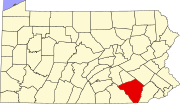Marietta, Pennsylvania
Marietta, Pennsylvania | |
|---|---|
 Old Town Hall | |
 Location in Lancaster County, Pennsylvania | |
 Marietta Location in Pennsylvania | |
| Coordinates: 40°03′26″N 76°33′21″W / 40.05722°N 76.55583°WCoordinates: 40°03′26″N 76°33′21″W / 40.05722°N 76.55583°W | |
| Country | United States |
| State | Pennsylvania |
| County | Lancaster |
| Government | |
| • Mayor | Harold Kulman |
| Area | |
| • Total | 0.75 sq mi (1.95 km2) |
| • Land | 0.75 sq mi (1.93 km2) |
| • Water | 0.01 sq mi (0.02 km2) |
| Elevation | 279 ft (85 m) |
| Population | |
| • Total | 2,588 |
| • Estimate (2019)[3] | 2,604 |
| • Density | 3,485.94/sq mi (1,345.93/km2) |
| Time zone | UTC-5 (EST) |
| • Summer (DST) | UTC-4 (EDT) |
| ZIP code | 17547 |
| Area code(s) | 717 and 223 |
| School district | Donegal School District |
| Website | www |
Marietta is a borough in Lancaster County, Pennsylvania, United States. The population was 2,588 at the 2010 census.[2] It is located on the east bank of the Susquehanna River northwest of Columbia.
Geography[]
Marietta is located in western Lancaster County at 40°3′26″N 76°33′21″W / 40.05722°N 76.55583°W (40.057169, -76.555955).[4] It is bordered to the north, east, and west by East Donegal Township, and to the south, across the Susquehanna River, by Hellam Township in York County.
According to the United States Census Bureau, the borough has a total area of 0.75 square miles (1.9 km2), of which 0.007 square miles (0.018 km2), or 0.93%, are water.[1]
Market Street runs the whole length of the town. The east/west divider is Waterford Avenue. Pennsylvania Route 441 passes just north of the borough and forms part of its northeast border; the highway leads southeast 3.5 miles (5.6 km) to Columbia and northwest (upriver) 15 miles (24 km) to Middletown.
History[]
In 1727, James Anderson made a lottery that laid out part of present-day Marietta. Later David Cook laid another portion of present-day Marietta. Further development by Jacob Grosh, John Myers, John Peadan, James Mehaffey, Benjamin Long, and James Huffy laid out the rest of present-day Marietta. In 1812, the borough was incorporated, merging all the areas of town except for the western portion of the borough which was extended into Marietta at a later date.
For the first couple years of existence, the growth of the borough was meager. Then an economic crisis struck the town, not relenting until around 1830. Then throughout the years, industries such as timber and iron smelting provided many economic opportunities in the borough.[5]
The borough's name is an amalgamation of the first names of Mary Cook and Etta Anderson, the wives of two first settlers.[6]
The Ashley and Bailey Silk Mill, Joseph Bucher House, Chickies Historic District, Linden House, and Marietta Historic District are listed on the National Register of Historic Places.[7]
Demographics[]
| Historical population | |||
|---|---|---|---|
| Census | Pop. | %± | |
| 1840 | 1,428 | — | |
| 1850 | 2,099 | 47.0% | |
| 1860 | 2,186 | 4.1% | |
| 1870 | 2,397 | 9.7% | |
| 1880 | 2,503 | 4.4% | |
| 1890 | 2,402 | −4.0% | |
| 1900 | 2,469 | 2.8% | |
| 1910 | 2,079 | −15.8% | |
| 1920 | 1,735 | −16.5% | |
| 1930 | 1,969 | 13.5% | |
| 1940 | 2,128 | 8.1% | |
| 1950 | 2,442 | 14.8% | |
| 1960 | 2,385 | −2.3% | |
| 1970 | 2,838 | 19.0% | |
| 1980 | 2,740 | −3.5% | |
| 1990 | 2,778 | 1.4% | |
| 2000 | 2,689 | −3.2% | |
| 2010 | 2,588 | −3.8% | |
| 2019 (est.) | 2,604 | [3] | 0.6% |
| Sources:[8][9][10] | |||
As of the census[9] of 2000, there were 2,689 people, 1,092 households, and 723 families residing in the borough. The population density was 3,587.0 people per square mile (1,384.3/km2). There were 1,168 housing units at an average density of 1,558.1 per square mile (601.3/km2). The racial makeup of the borough was 95.83% White, 2.49% African American, 0.15% Native American, 0.15% Asian, 0.04% Pacific Islander, 0.52% from other races, and 0.82% from two or more races. Hispanic or Latino of any race were 1.90% of the population.
There were 1,092 households, out of which 32.2% had children under the age of 18 living with them, 51.3% were married couples living together, 10.7% had a female householder with no husband present, and 33.7% were non-families. 25.8% of all households were made up of individuals, and 7.7% had someone living alone who was 65 years of age or older. The average household size was 2.46 and the average family size was 2.99.
In the borough the population was spread out, with 24.8% under the age of 18, 8.1% from 18 to 24, 34.3% from 25 to 44, 22.0% from 45 to 64, and 10.8% who were 65 years of age or older. The median age was 36 years. For every 100 females, there were 99.9 males. For every 100 females age 18 and over, there were 97.7 males.
The median income for a household in the borough was $40,563, and the median income for a family was $46,905. Males had a median income of $33,783 versus $21,863 for females. The per capita income for the borough was $19,265. About 6.7% of families and 9.2% of the population were below the poverty line, including 11.8% of those under age 18 and 11.0% of those age 65 or over.
Government[]
| Council member | Party | Electoral history[11] |
|---|---|---|
| Glen Mazis | Democrat | Elected ???; Reelected 11/07/2017 |
| Robert W. Shambaugh | Democrat | Elected 11/07/2017 |
| Louis C. McKinney Sr. | Democrat | Elected 11/07/2017 |
| William A. Dalzell Jr. | Democrat | Elected 11/07/2017 |
| Bridey Hannold | Democrat | Elected |
| Wayne Angelo | Elected | |
| Frederick States | Elected |
Education[]
Primary and secondary education in the borough of Marietta is provided by the Donegal School District. Students kindergarten through second grade attend the Donegal Primary School in Mount Joy. Students third grade through sixth grade attend the Donegal Intermediate School located on PA 441 just outside the borough. Students seventh grade through eighth grade attend the Donegal Junior High School in Mount Joy. Students ninth grade through twelfth grade attend the Donegal Senior High School in Mount Joy.
Notable people[]
- Henry B. Cassel, Republican member of the U.S. House of Representatives
- Alan Dawson (1929-1996), jazz drummer and percussion teacher based in Boston; born in Marietta.
- David Hickernell, Republican member of the Pennsylvania House of Representatives
Gallery[]
Post office
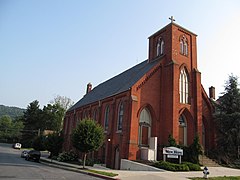
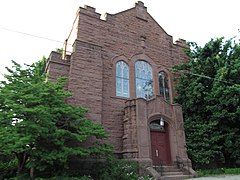
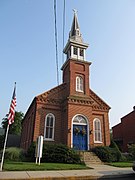
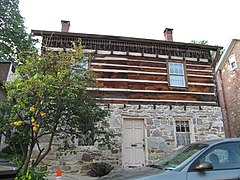

First National Bank Building
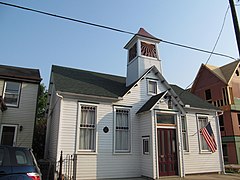
References[]
- ^ Jump up to: a b "2019 U.S. Gazetteer Files". United States Census Bureau. Retrieved July 28, 2020.
- ^ Jump up to: a b "Total Population: 2010 Census DEC Summary File 1 (P1), Marietta borough, Pennsylvania". data.census.gov. U.S. Census Bureau. Retrieved September 8, 2020.
- ^ Jump up to: a b "Population and Housing Unit Estimates". United States Census Bureau. May 24, 2020. Retrieved May 27, 2020.
- ^ "US Gazetteer files: 2010, 2000, and 1990". United States Census Bureau. 2011-02-12. Retrieved 2011-04-23.
- ^ Bailey, Stephen. "The History of Marietta, Pennsylvania". www.mariettapa.com. Archived from the original on June 13, 2016. Retrieved June 15, 2016.
- ^ Espenshade, Abraham Howry (1925). Pennsylvania Place Names. Evangelical Press. p. 312. ISBN 978-0-8063-0416-8.
- ^ "National Register Information System". National Register of Historic Places. National Park Service. July 9, 2010.
- ^ "Census of Population and Housing". U.S. Census Bureau. Retrieved 11 December 2013.
- ^ Jump up to: a b "U.S. Census website". United States Census Bureau. Retrieved 2008-01-31.
- ^ "Incorporated Places and Minor Civil Divisions Datasets: Subcounty Resident Population Estimates: April 1, 2010 to July 1, 2012". Population Estimates. U.S. Census Bureau. Archived from the original on 11 June 2013. Retrieved 11 December 2013.
- ^ "Election Returns available". Ice1.co.lancaster.pa.us. Archived from the original on 2012-07-23. Retrieved 2012-11-08.
External links[]
| Wikimedia Commons has media related to Marietta, Pennsylvania. |
- Pennsylvania populated places on the Susquehanna River
- Populated places established in 1803
- Boroughs in Lancaster County, Pennsylvania
- 1803 establishments in Pennsylvania










